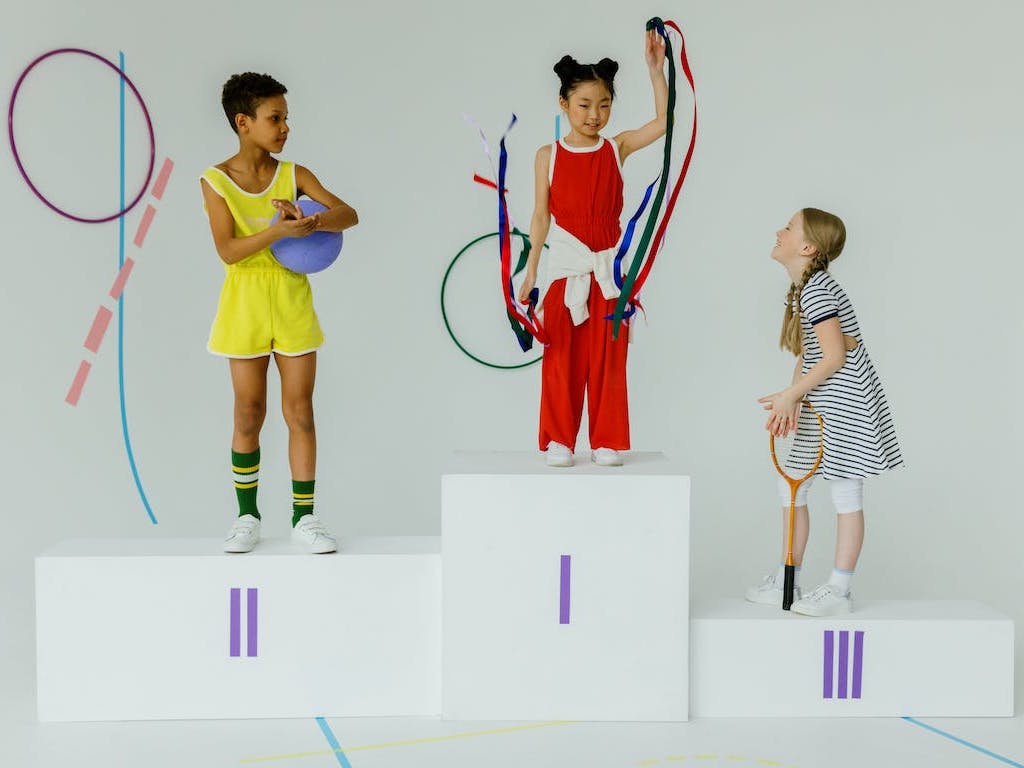SingaporeMotherhood | Preschooler & Up
January 2024
How to Talk to Your Child about Online Safety because your child WILL encounter Inappropriate Content Online

If you have a child between the ages of three and pre-teen, who uses the internet to learn and play, read this. Four in five children in Singapore spend one to six hours online daily for education and entertainment. And at least once in the past year, one in two of these children would have seen misinformation (55.4%), deceptive ads or spam (50.7%), or violent content (48.7%) online. This is what Google’s third APAC Kids and Families Online Safety Survey found.
Not your child, you say? Not yet, perhaps. Still, who hasn’t let their child watch a video on the phone so they can hurriedly gulp down a meal? But hey, we’re not judging. Juggling parental responsibilities with personal tasks can be challenging. It’s no wonder that parents often allow their children to use electronic devices as a means to free up time for themselves and attend to chores, work, or simply have a brief respite.
While this strategy offers a temporary solution, it is important to balance device usage with other activities that foster a child’s holistic development. More crucially, if your child is using the internet independently, it is essential to teach them about online safety.
(See also: 10 REMOTE LEARNING HACKS TO HELP YOU ACE THE HOMEBASED LEARNING #HBL LIFE)
“More kids and teens nowadays are savvy navigators of the digital world. Our survey results highlight the urgent need to make online safety a central part of their conversations at home,” said Norman Ng, Regional Operations Lead, Trust & Safety Global Engagements, at Google Singapore.
But parents (us as well!) often find it hard to talk about online safety with their children. So we asked the experts – Shem Yao, Manager of Digital Wellness at TOUCH Wellness Group, TOUCH Community Services, and Alsen Chanamuto, Schools Engagement Manager at the Centre for Fathering – to tell us. Here’s what they said.
First, Parents have to Know What’s Happening

What’s happening online now is not new. Child exploitation and grooming have been an ongoing concern for a long time, Shem reminds us. Interactive online platforms, such as IRC (Internet Relay Chat), online games with in-game chat function, forums, blogs, and the social media platforms have allowed grooming behaviour to be more proliferated, with more anonymity, and are easily accessible by everyone, including children, youths and adults.
The nature of the problem is multi-faceted, he adds:
- Children who are given access to these platforms lack the right skill sets and emotional maturity to deal with such interactions.
- The sexualisation of children and how they should behave and look to get noticed, go viral etc., which leads to the desensitisation and normalisation of grooming behaviour.
(See also: WHAT’S THE RIGHT AGE TO GET MY CHILD HIS FIRST SMARTPHONE?)
For parents, gatekeeping needs to be coupled with the ability and knowledge to teach their children how to navigate interactions online as the child gets older, Shem believes.
While a lot is being done by the government and relevant agencies to create a safer digital landscape, it would be a lot easier when families and parents take a more intentional approach in equipping their children with the knowledge to navigate the digital space safely, scaffolding their digital experiences accordingly.
Shem Yao, Manager of Digital Wellness at TOUCH Wellness Group, TOUCH Community Services
6 Tips for Starting Conversations about Online Safety with your Child

In general, says Alsen, there are certain things parents should keep in mind when starting conversations about online safety with their children.
# 1: Be proactive, rather than reactive. Engage proactively with kids around their phone/ipad/computer usage. Be gentle and clear about the dangers, challenges and expectations of screen usage.
# 2: Pay close attention and monitor the amount of time you and your kids are spending on social media.
(See also: CAN TECH BE GOOD FOR KIDS? YES, SAYS THIS DOCTOR)
# 3: Be a role model. Whether we like it or not, kids watch:
- what we do
- how we relate
- how we react
- what we prioritise
- how we speak
- what we say about others
# 4: Before you allow your child to try an app/game/website, try it yourself if possible. Search online for anything you don’t understand.
# 5: Create a safe and supportive environment where your child feels comfortable talking to you about their online experiences.
# 6: Review and update your approach as your child grows, and technology evolves.
When you are ready to start, follow these guides base on your child’s age.
Online safety for children aged 3 to 6 years

Shem:
Supervise your child when they are using the internet, and limit the platforms they can access and the amount of time they spend online. Children should not be chatting with anyone online or sharing their personal information anywhere.
Alsen:
🤖 Tip 1:
Start training your kids to use and enjoy media wisely and responsibly. Teach them what messages the media sells. Teach your child where their worth really comes from, and to build their life on what truly lasts and find where real happiness lies. This takes an intentional conversation from parents. And it is a process, not a one-time conversation.
🤖 Tip 2:
Identify a couple of messages you feel are critically important for your children to receive from you as a parent. Spend some time identifying which topics or messages you most want your kids to receive from you and not from advertisers, music, or media portrayal. Sit down with your kids and invite discussion, reflection and participation. Don’t start with a show, movie, or video game that is immediately controversial. Keep things simple by picking media that’s already acceptable (such as an advertisement, or a short clip). With practice and time, you and your kids can move on to examining whole shows or movies.
🤖 Tip 3:
Encourage open communication. Create an environment where they feel comfortable discussing their online experiences with you. Let them know they can come to you if they see something they don’t understand or that makes them feel uneasy.
Online safety for children aged 7 to 10 years

Shem:
Teach your child about age-appropriate sexuality topics, modesty, the content they will encounter online, and how to respond to it. Parents having a clear understanding of the concept of good touch and bad touch (good touches are those that are not abusive, such as hugs from family, a pat on the back, or shaking hands, while bad touches are those that are abusive and involve touching a child’s private body parts), recognising red flag behaviours and how to respond appropriately would go a long way in protecting the children.
(See also: WHAT KIND OF PARENT ARE YOU, BASED ON YOUR CHINESE ZODIAC?)
Alsen:
🤖 Tip 1:
Give kids space to find the right balance in spending time doing homework, doing chores, and being together as a family. The online world can take them away from that and finding that balance is tough. It can be just as tough for adults to discipline themselves.
🤖 Tip 2:
Discuss online safety. Teach them about the importance of not sharing personal information, and what to do if they see something that makes them uncomfortable. Make sure they understand the difference between good and bad touch, both in the physical world and online.
Online safety for children aged 11 years and older

Shem:
Pre-teens and teens are at the age where they are maturing and are navigating digital devices independently. Make an effort to build strong relationships and connections with them to better engage in difficult conversations about their identity, sexuality, relationships with different genders, boundaries and the importance of saying no and how to say it etc.
Alsen:
🤖 Tip 1:
Filter out the negative aspects of social media. Our children haven’t developed, or are still developing a filter. There are a number of dangers of social media, like comparison, inappropriate content, bullying etc. Talk to them about what they see and how they feel about it.
(See also: CYBERBULLYING IN SINGAPORE: IS MY CHILD A VICTIM?)
🤖 Tip 2:
Discuss the consequences. Talk to them about the potential long-term consequences of sharing inappropriate content, cyberbullying, or engaging in risky online behaviour. Ensure they understand the legal and personal repercussions.
🤖 Tip 3:
Teach them how to use privacy settings and reporting tools. Teach them how to adjust privacy settings on social media platforms and how to use reporting tools to flag inappropriate content or users.
🤖 Tip 4:
Maintain open dialogue. Keep an open line of communication about their online experiences. Let them know you’re there to help and support them, and discuss any concerns they may have. As parents we want them to feel safe enough to come back to us when they encounter any problems.
(See also: TWEENS: 8 FAIL-PROOF STRATEGIES TO BETTER YOUR RELATIONSHIP WITH THEM)
Doing more to ensure our children’s online safety
This year, TOUCH Community Services will be launching a new series of digital parenting programmes and workshops that will help parents to understand online harms and interactions to safeguard their children’s digital well-being.
Google has tools and resources to help parents create a safer experience online for their families and
kids, including:
- Age-appropriate content restrictions on Google Play and Search via Family Link that allows parents to adjust parameters for their children’s devices; and SafeSearch, which is on by default for signed-in users under 18 and helps filter inappropriate, explicit, and mature content. The Kids tab on Google Play Store is also available for children to discover age appropriate applications.
- SafeSearch’s new blurring setting: Automatically blurs explicit imagery, such as adult or graphic violent content, by default when it appears in Search results.
- YouTube Kids: Provides children with a more contained environment to freely explore content online.
- Free and useful resources: The library of Digital Safety Resources and the Be Internet Awesome program teaches kids the fundamentals of digital citizenship and safety so they can explore the online world with confidence.
Featured image: Ketut Subiyanto on Pexels
All content from this article, including images, cannot be reproduced without credits or written permission from SingaporeMotherhood.
Follow us on Facebook, Instagram, and Telegram for the latest article and promotion updates.





